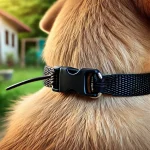When your beloved pet's leash or collar unexpectedly breaks, cable ties can provide a quick and effective temporary fix. This guide explores best practices for using cable ties to repair pet accessories, ensuring your furry friend remains safe and secure during walks or outdoor activities.
Using cable ties to repair broken pet leashes and collars offers a simple yet sturdy solution for pet owners facing sudden equipment failures. We'll delve into techniques and considerations that ensure your pet's safety while you await a permanent replacement.
Why Cable Ties Excel for Pet Accessory Repairs
Cable ties present unique advantages when it comes to repairing pet leashes and collars. Their strength and flexibility make them ideal for quick fixes on various materials, adapting to different types of damage. Furthermore, cable ties offer rapid installation, allowing pet owners to swiftly address breaks or tears in leashes and collars. Their durability ensures that temporary repairs can withstand the pulling and tugging typical of pet walks.
Warning: Do not use cable ties as a permanent solution for repairing broken pet leashes or collars. While they provide a quick fix in emergencies, cable ties are not designed to withstand prolonged stress or the strength of a pulling pet. If you're unsure of how to properly secure the leash or collar, avoid attempting repairs on your own. Always prioritize your pet's safety and seek a permanent replacement as soon as possible. Consult a professional for guidance if necessary.
Selecting the Appropriate Cable Ties for Pet Accessory Repairs
Choosing the right cable ties is crucial for effective and safe pet accessory repairs. Consider factors such as length, width, and material when making your selection. Opt for strong, durable ties that can withstand the force exerted by your pet. Additionally, select ties with sufficient length to accommodate the size of the break and the thickness of the leash or collar material.
Material Considerations
Different cable tie materials offer various benefits for pet accessory repairs:
- Nylon ties provide excellent flexibility and strength.
- UV-resistant ties offer better durability for outdoor use.
- Reusable ties allow for adjustments and easy removal when a permanent fix is available.
Size and Strength Factors
The size and strength of your cable ties directly impact their effectiveness:
- Longer ties allow for securing larger breaks or wrapping around thicker materials.
- Wider ties distribute force more evenly, reducing the risk of further damage.
- Higher tensile strength ensures the ties can withstand the pulling force of your pet.
Step-by-Step Guide to Repairing Pet Leashes and Collars
Follow these steps to effectively repair your pet's leash or collar using cable ties:
- Assess the damage and clean the area around the break.
- If possible, align the broken ends of the leash or collar.
- Thread a cable tie through both sides of the break, ensuring it wraps around securely.
- Tighten the cable tie, but avoid over-tightening to prevent discomfort for your pet.
- Use additional ties for extra security, especially for larger breaks or heavier pets.
- Trim any excess tie length, ensuring no sharp edges remain.
Proper Tie Placement

Strategic placement of cable ties ensures optimal safety and comfort:
- Use multiple ties for longer breaks, spacing them evenly.
- For collars, ensure ties are placed to avoid rubbing against your pet's neck.
- Create a slight overlap in the repaired area for added strength.
Maintaining Repaired Pet Accessories
Regular maintenance ensures your temporary repair remains effective:
- Inspect the repaired area before each use, checking for any signs of wear or loosening.
- Replace cable ties if they show signs of stretching or damage.
- Monitor your pet's comfort and behavior to ensure the repair isn't causing any irritation.
Addressing Ongoing Use Challenges
As you continue to use the repaired accessory:
- Be mindful of increased stress on the repaired area during walks or play.
- Consider using a backup leash or collar for added security.
- Plan to replace the damaged item as soon as possible with a permanent solution.
Advanced Techniques for Comprehensive Repairs
For more extensive damage, consider these advanced repair techniques:
- Create a reinforced patch using a small piece of fabric secured with multiple cable ties.
- Use a combination of cable ties and strong adhesive tape for added durability.
- Implement a temporary harness system using cable ties if the collar is severely damaged.
Innovative Repair Solutions
Explore creative ways to enhance your temporary repairs:
- Use colored cable ties that match the leash or collar for a more aesthetically pleasing fix.
- Consider cable ties with a quick-release mechanism using specially designed breakaway cable ties for safety.
Safety Considerations
While repairing pet accessories is generally safe, keep these precautions in mind:
- Ensure no sharp edges are left exposed after trimming cable ties.
- Avoid repairs on choke chains or prong collars, as these require professional attention.
- Never use cable ties directly on your pet's skin or fur.
Always prioritize your pet's safety—immediately replace a broken leash or collar with a new one. Additionally, consult your cable tie supplier to ensure you're using the correct type for any temporary repair, and always check with your vet for extra safety guidance.
When Not to Use Cable Ties as a Quick Fix
- For Strong or Large Dogs: Cable ties are not designed to withstand the strength and pulling force of large or powerful dogs. They can break under tension, leading to dangerous situations.
- On Chewed or Severely Damaged Collars: If a collar is significantly damaged, especially by chewing, do not attempt to repair it with cable ties. This could cause further harm to your dog.
- If the Leash or Collar is Worn Out: A worn leash or collar may fail without warning. Cable ties won’t offer the necessary support to prevent breakage.
- As a Long-Term Solution: Cable ties are temporary fixes only. If you cannot immediately replace the leash or collar, avoid relying on cable ties for an extended period.
Always err on the side of caution when it comes to your pet's safety, and never compromise with makeshift solutions when proper replacements are readily available.
Environmental Impact
Consider the environmental aspects of your repair methods:
- Opt for biodegradable cable ties if the repair is truly temporary.
- Properly dispose of any trimmed tie pieces to prevent wildlife hazards.
- Consider using eco-friendly alternatives like hemp cord for certain types of repairs.
Wrapping Up
Using cable ties to repair broken pet leashes and collars offers a quick and effective solution to keep your furry companions safe during unexpected equipment failures. By following these guidelines and exploring various repair techniques, you'll ensure your pet remains secure until a permanent replacement can be obtained.
Remember to prioritize your pet's safety and comfort and regularly assess the condition of your temporary repairs.
For more insights and tips on cable ties and other related products, explore cabletiesunlimited.com and follow us on our social media communities on Facebook and Instagram!

